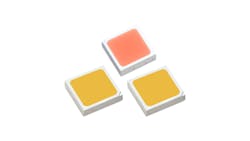Lumileds has announced the immediate availability of the Luxeon SkyBlue LEDs in partnership with BIOS (Biological Innovations and Optimization Systems) LLC, also known as BIOS Lighting. The new offering is termed an LED kit by Lumileds in its datasheet because the human-centric lighting concept requires that luminaire developers use groups of three packaged LEDs that together deliver the spectral power distribution (SPD) designed by BIOS to enhance sleep patterns, improve productivity, and generally raise the comfort level of people in a space. Each kit includes one of the new SkyBlue LEDs and two Luxeon 3030 HE Plus phosphor-converted white LEDs.
The two companies announced the SkyBlue technology concept back in November 2020. BIOS had previously used a proprietary multichannel LED approach to deliver solid-state lighting (SSL) products that delivered on the day and night SPDs defined on the company’s website. While many companies have developed tunable-SPD products intended to positively influence human health and wellbeing, most use blue energy from the standard blue peak witnessed in phosphor-converted white LEDs around the 450-nm wavelength. BIOS had developed an SPD with a larger blue peak around 490 nm because that wavelength is nearer to center of circadian sensitivity in humans. BIOS isn’t alone in the belief that energy in the cyan region has a greater impact on the circadian system. Circadian ZircLight research has identified maximum circadian sensitivity at 477 nm.
In November, Lumileds did not publish the SPD of the SkyBlue technology, but rather implied it would ultimately enable product developments with day and night SPDs such as those from BIOS. Now the company has published an SPD of the kit of three LEDs characterized essentially as a light engine. That SPD is pictured nearby. And it certainly looks similar to the BIOS day-mode SPD.
The SPD of the 3030 HE Plus LEDs is easily found on the Lumileds website. We’d presume that you need two of those LEDs to a single SkyBlue LED to get the proper balance of energy in the green, yellow, and red regions. The SkyBlue LED, seen with a reddish phosphor in the nearby photo, would add the cyan peak that is relatively the highest energy magnitude in the SPD. The SkyBlue LED also probably adds some magnitude and possibly nudges red energy a bit wider relative to the 3030 HE Plus alone.
All of the specifications for the new offering are defined by the kit of three LEDs. In aggregate, the kit can produce 58–64 lm depending on CCT. So a product such as a retrofit lamp for use in a bedroom might require ten or more kits of LEDs. Integrated luminaires would need more for target applications that Lumileds says include schools, offices, healthcare facilities, factories, and more.
The advantage over prior implementations of the BIOS SPD will come in efficacy and cost. Efficacy ranges from 148–160 lm/W at 50 mA of drive current. And of course the LED kits will offer a somewhat turnkey approach to human-centric lighting. “Integrating BIOS Lighting’s expertise in circadian lighting spectral requirements with Lumileds expertise in LED and solution development enabled this breakthrough approach to luminaire development,” said Willem Sillevis-Smitt, head of marketing at Lumileds. “Our direct access to the full production from our factories and the detailed information we have about every LED allows us to dramatically simplify engineering for OEMs. LUXEON SkyBlue is simply the fastest, simplest, and most cost-effective path to producing a circadian lighting luminaire.”
The kit specification also includes rated melanopic ratios. The specified M/P ratios are 0.74, 0.84, and 0.94 respectively for 3000K, 3500K, and 4000K CCTs. CRI is 83–85, yet the R9 rating is 90. That red performance equates to good Cyanosis Observation performance. “As the science has progressed, human-centric lighting has quickly risen in importance for both lighting designers and end-users,” said Mark McClear, COO at BIOS Lighting. “Only spectrally optimized circadian lighting delivers the specific and measurable physiological impact that is desired in schools, offices, factories, health-care settings and similar locations.”
LEDs Magazine chief editor MAURY WRIGHT is an electronics engineer turned technology journalist, who has focused specifically on the LED & Lighting industry for the past decade.
For up-to-the-minute LED and SSL updates, why not follow us on Twitter? You’ll find curated content and commentary, as well as information on industry events, webcasts, and surveys on our LinkedIn Company Page and our Facebook page.






